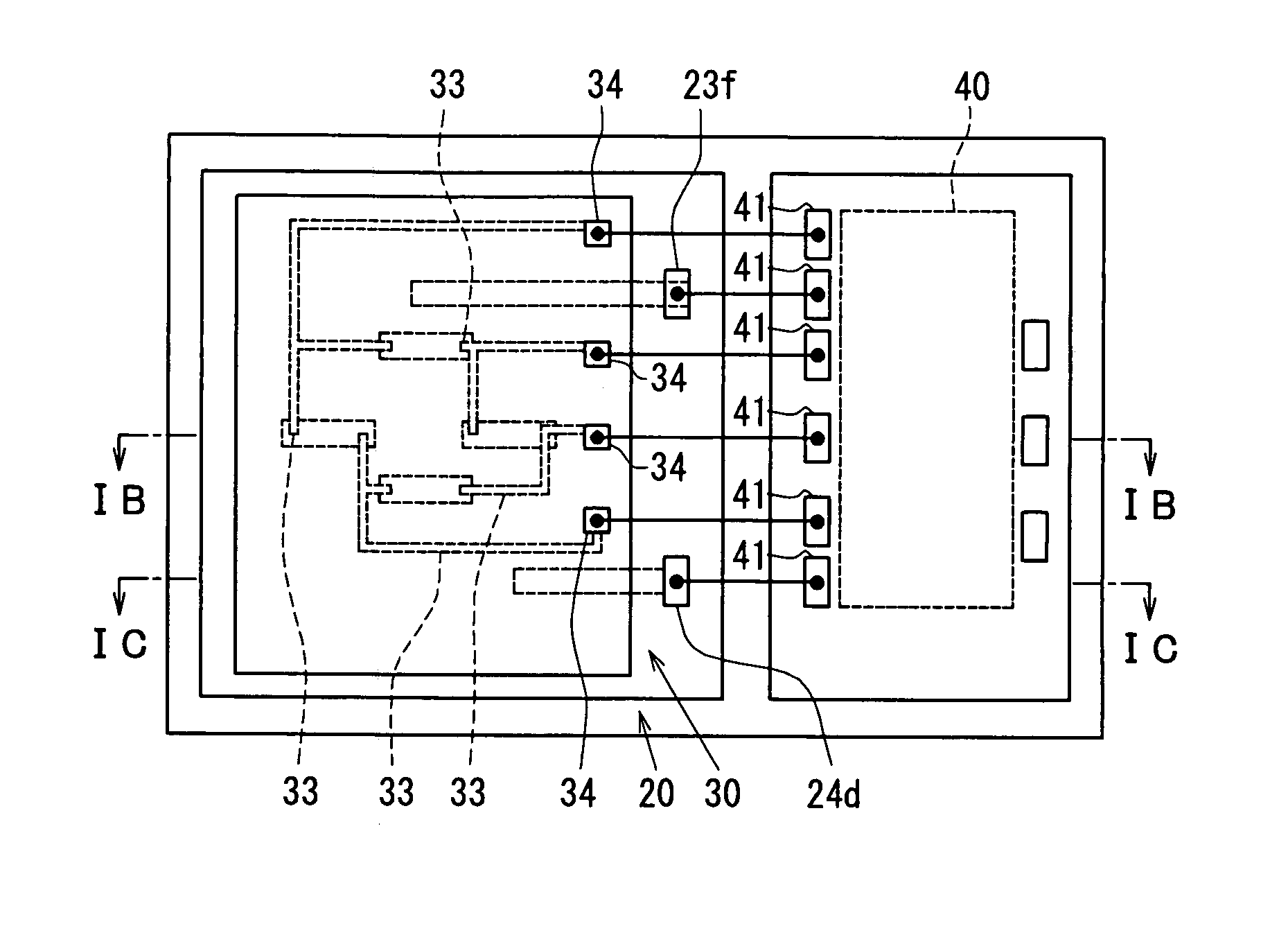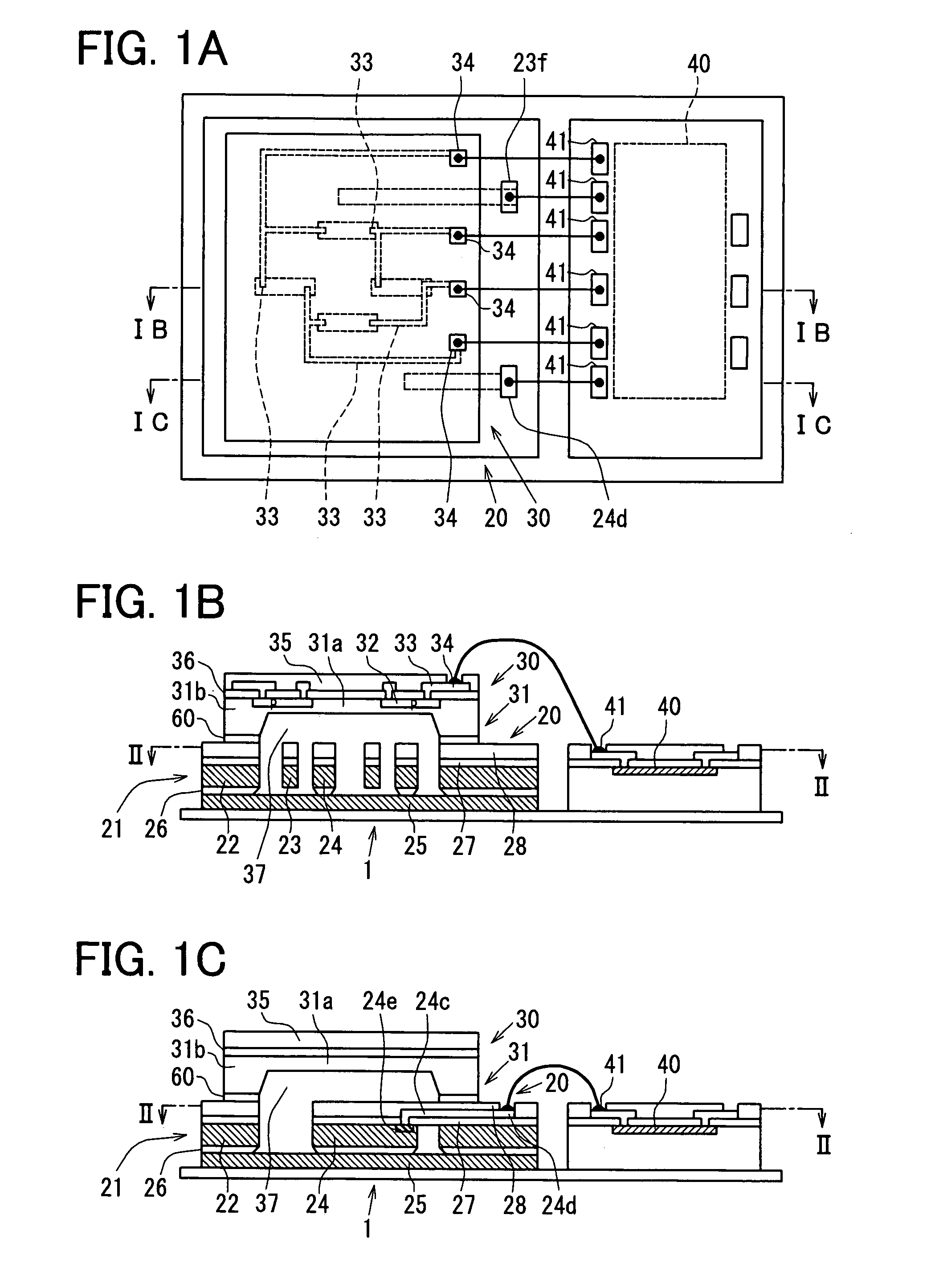Physical quantity sensor
a sensor and physical technology, applied in the field of physical quantity sensors, can solve the problems of deterioration of air tight characteristics, large number of structural members, complex structure of sensors, etc., and achieve the effect of convenient retrieval
- Summary
- Abstract
- Description
- Claims
- Application Information
AI Technical Summary
Benefits of technology
Problems solved by technology
Method used
Image
Examples
second embodiment
[0097]Referring now to FIG. 9A to FIG. 9C, a description is made of a composite type dynamic amount sensor 1 according to a second embodiment. This embodiment is different from the above-described first embodiment as to the following technical point: That is, a piezoelectric type pressure sensor 30 is adhered to a capacitance type acceleration sensor 20 by employing solder 91 and 92, and an air tight characteristic of a reference pressure chamber 37 is secured by an air tight annular ring 93. It should also be noted that the same reference numerals shown in the first embodiment will be employed as those for denoting the same, or similar structures indicated in the second embodiment, and explanations in this embodiment are omitted.
[0098]FIG. 9A is a sectional view for indicating the composite type dynamic amount sensor 1 according to the second embodiment, namely such a sectional view, taken along a line IXA-IXA of FIG. 9B and FIG. 9C. Also, FIG. 9B corresponds to FIG. 1B in the firs...
third embodiment
[0108]Referring now to FIG. 10A to FIG. 10C, a description is made of a composite type dynamic amount sensor 1 according to a third embodiment. This embodiment is different from the above-described second embodiment as to the following technical point: That is, the air tight characteristic of the reference pressure chamber 37 is secured by employing an NCF (Non-Conductive Film) 101. It should also be noted that the same reference numerals shown in the first embodiment, or the second embodiment will be employed as those for denoting the same, or similar structures indicated in the third embodiment, and explanations in this embodiment are omitted.
[0109]FIG. 10A is a sectional view for indicating the composite type dynamic amount sensor 1 according to the third embodiment, namely such a sectional view, taken along a line XA-XA of FIG. 10B and FIG. 10C. Also, FIG. 10B corresponds to FIG. 1B in the first embodiment, and FIG. 10C corresponds to FIG. 1C in the first embodiment.
[0110]As sho...
fourth embodiment
[0117]Referring now to FIG. 11, a description is made of a composite type dynamic amount sensor 1 according to a fourth embodiment. The fourth embodiment has the below-mentioned technical different points from those of the first embodiment. That is, in this embodiment, while a penetration electrode 111 is provided on a diaphragm 31, a signal of a capacitance type acceleration sensor 20 can be derived from the diaphragm 31 through the penetration electrode 111. It should be understood that the same reference numerals shown in the above-described respective embodiments will be employed as those for denoting the same, or similar structural elements in the fourth embodiment, and descriptions thereof are omitted.
[0118]FIG. 11 is a sectional view for showing the composite type dynamic amount sensor 1 according to the fourth embodiment, and corresponds to FIG. 1C in the first embodiment.
[0119]As indicated in FIG. 11, the penetration electrode 111 and an insulating film 112 have been formed...
PUM
 Login to View More
Login to View More Abstract
Description
Claims
Application Information
 Login to View More
Login to View More - R&D
- Intellectual Property
- Life Sciences
- Materials
- Tech Scout
- Unparalleled Data Quality
- Higher Quality Content
- 60% Fewer Hallucinations
Browse by: Latest US Patents, China's latest patents, Technical Efficacy Thesaurus, Application Domain, Technology Topic, Popular Technical Reports.
© 2025 PatSnap. All rights reserved.Legal|Privacy policy|Modern Slavery Act Transparency Statement|Sitemap|About US| Contact US: help@patsnap.com



